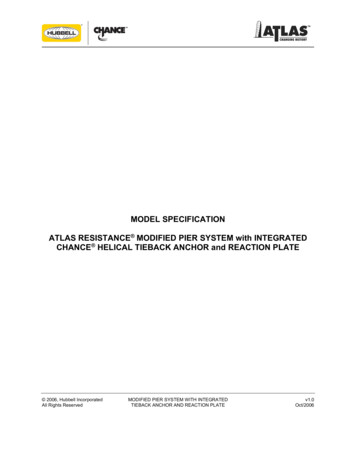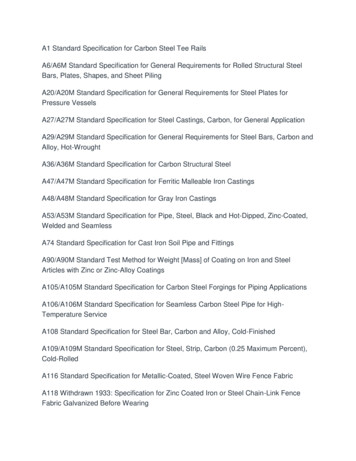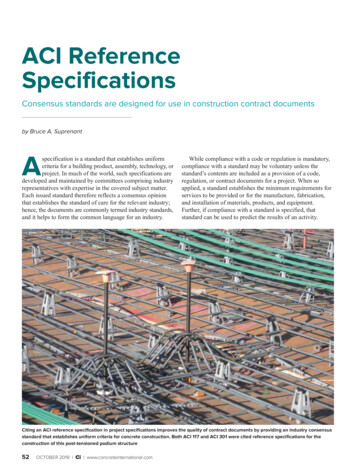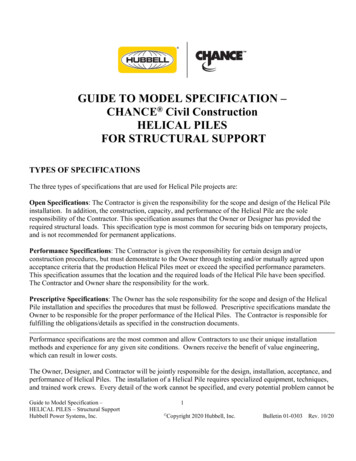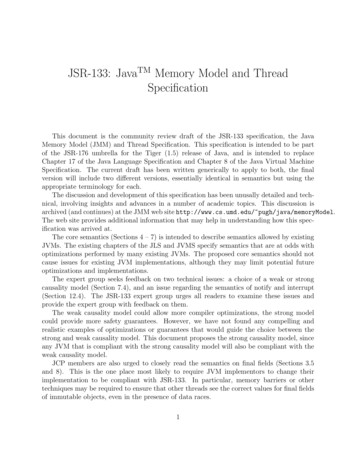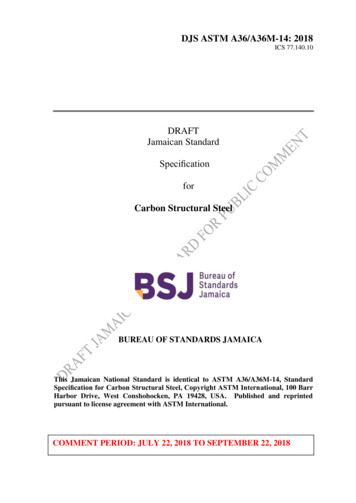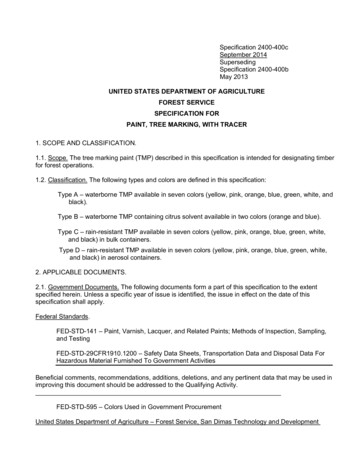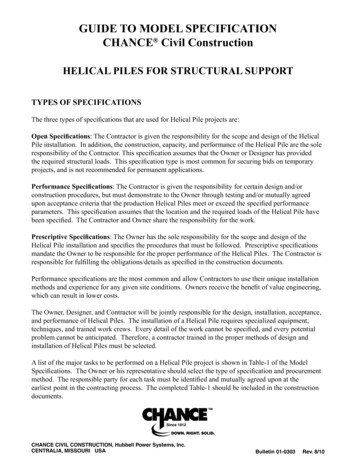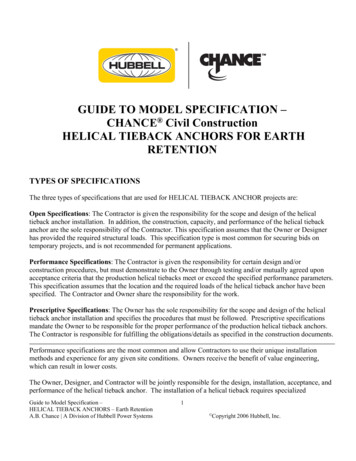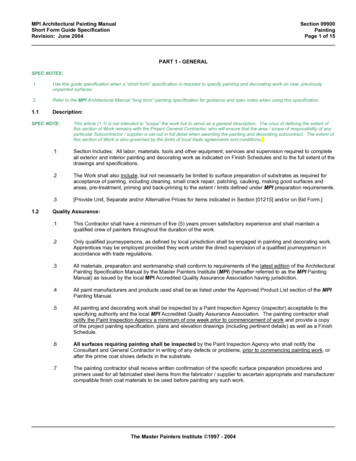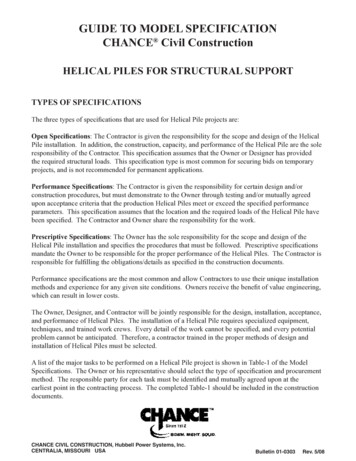
Transcription
GUIDE TO MODEL SPECIFICATIONCHANCE Civil ConstructionHELICAL PILES FOR STRUCTURAL SUPPORTTYPES OF SPECIFICATIONSThe three types of specifications that are used for Helical Pile projects are:Open Specifications: The Contractor is given the responsibility for the scope and design of the HelicalPile installation. In addition, the construction, capacity, and performance of the Helical Pile are the soleresponsibility of the Contractor. This specification assumes that the Owner or Designer has providedthe required structural loads. This specification type is most common for securing bids on temporaryprojects, and is not recommended for permanent applications.Performance Specifications: The Contractor is given the responsibility for certain design and/orconstruction procedures, but must demonstrate to the Owner through testing and/or mutually agreedupon acceptance criteria that the production Helical Piles meet or exceed the specified performanceparameters. This specification assumes that the location and the required loads of the Helical Pile havebeen specified. The Contractor and Owner share the responsibility for the work.Prescriptive Specifications: The Owner has the sole responsibility for the scope and design of theHelical Pile installation and specifies the procedures that must be followed. Prescriptive specificationsmandate the Owner to be responsible for the proper performance of the Helical Piles. The Contractor isresponsible for fulfilling the obligations/details as specified in the construction documents.Performance specifications are the most common and allow Contractors to use their unique installationmethods and experience for any given site conditions. Owners receive the benefit of value engineering,which can result in lower costs.The Owner, Designer, and Contractor will be jointly responsible for the design, installation, acceptance,and performance of Helical Piles. The installation of a Helical Pile requires specialized equipment,techniques, and trained work crews. Every detail of the work cannot be specified, and every potentialproblem cannot be anticipated. Therefore, a contractor trained in the proper methods of design andinstallation of Helical Piles must be selected.A list of the major tasks to be performed on a Helical Pile project is shown in Table-1 of the ModelSpecifications. The Owner or his representative should select the type of specification and procurementmethod. The responsible party for each task must be identified and mutually agreed upon at theearliest point in the contracting process. The completed Table-1 should be included in the constructiondocuments.CHANCE CIVIL CONSTRUCTION, Hubbell Power Systems, Inc.CENTRALIA, MISSOURI USABulletin 01-03031Rev. 5/08
The process of continuous communication between all the parties involved is essential to achieve asatisfactory result. Clear communication and close cooperation are particularly important in the start-upphase and in testing. In addition, a timely preparation and review of all submittals is critical.This model specification can be adapted to each of the three types of specifications. However, it isprimarily written for the performance type. The identity of the “Contractor” and the “Owner” is alwayswell defined, unlike that of the “Designer” or “Engineer”. For example, the “Engineer” may be anemployee(s) of the Contractor, or a third party consultant hired to secure a lower cost alternative duringthe bidding process. In contrast, the “Engineer” may be the Owner, an employee(s) of the Owner,or a representative hired by the Owner. It is recommended that the Engineer be a third party agencyemployed by the Owner to serve in the owner’s best interests during the various stages of the contract.For purposes of this Model Specification, the subject is a high capacity Helical Pile manufactured byCHANCE Civil Construction. At present, maximum working or design loads range between 12.5 and50 tons. The Helical Pile consists of one or more helical bearing plates attached at the tip of a highstrength central steel shaft. The central steel shaft consists of either a solid square shaft of various sizes,or hollow pipe shaft of various diameters and wall thickness. The steel shafts are typically 1-1/2" to 8inches in diameter and will accept load directly axially and/or laterally to provide structural support.It is suggested that the specification writer accurately andcompletely modify this model to suit his/her particularcase.Items in italics as such may be considered as “Commentary” and as such may be deleted or retained tosuit the needs of the specification writer.The following is list of general references that will provide additional background to Helical Piletechnology:A. B. Chance Company, HELICAL PIER Foundation Systems, Technical Manual, Bulletin 01-9601,Copyright 2000 Hubbell, 210 North Allen St., Centralia, MO 65240A. B. Chance Company, Helical Screw Foundations – Design Manual for New Construction, Copyright2003 A.B. Chance Company, 210 North Allen St., Centralia, MO 65240Atlas Systems, Inc., Technical Manual, 2005, Copyright 2004 – Atlas Systems, Inc, 1026-B SouthPowell Road, Independence, MO 64056“BOCA Research Report 94-27”, Copyright 1996, BOCA Evaluation Services, Inc., Country Club Hills,IL 60478Goen, J. Lee, Compression Load on HELICAL PIER Foundation Systems Anchors – Design andConstruction, Bulletin 01-9304, Copyright 1998 Hubbell/Chance, 210 North Allen St., Centralia, MO65240Hargrave, R. L. and Thorsten, R. E., 1992. Helical Piers in Expansive Soils of Dallas, Texas.Proceedings 7th International Conference on Expansive Soils, Session 24, Bulletin 01-9311, Copyright2CHANCE CIVIL CONSTRUCTION, Hubbell Power Systems, Inc.CENTRALIA, MISSOURI USA
1993 A. B. Chance, 210 North Allen St., Centralia, MO 65240Hoyt, R.M. and Clemence, S.P., 1989. Uplift Capacity of Helical Anchors in Soil. Proceedings of the 12thInternational Conference on Soil Mechanics and Foundation Engineering, Vol. 2, pp. 1019-1022.“ICBO Evaluation Report - ER-5110”, Copyright 2001, ICBO Evaluation Service, Inc., Whittier, CA90601Pack, J. S., 2000. Design of Helical Piles for Heavily Loaded Structures. New Technological and DesignDevelopments in Deep Foundations, ASCE Geotechnical Special Publication, pp. 353- 367.“SBCCI Report No. 9504B”, Copyright 1999, SBCCI Public Safety Testing and Evaluation Services Inc.,Birmingham, AL 35213Seider, Gary L., “Versatile Steel Screw Anchors”, Structural Engineer Magazine, March 2000; Volume 1,Number 2, ppgs. 42-46.Wesolek, Dana A., Schmednecht, Fred C., and Seider, Gary L. “Helical Piers/Anchors in the ChicagoBuilding Code”, Proceedings of the DFI 30th Annual Conference on Deep Foundations, Chicago, IL pp.193-204.Model SpecificationTable of se of SpecificationScope of WorkQualifications of the ContractorRelated Project SpecificationsDefinitionsAllowable TolerancesQuality AssuranceDesign CriteriaGround Conditions2.2.12.22.32.42.52.6REFERENCED CODES AND STANDARDSAmerican Society for Testing and MaterialsAmerican Welding SocietyAmerican Society of Civil EngineersDeep Foundations InstitutePost Tensioning InstituteSociety of Automotive Engineers3.3.13.23.33.4SUBMITTALSConstruction SubmittalsInstallation RecordsTest ReportsCloseout Submittals4.4.14.24.34.44.54.6PRODUCTS AND MATERIALSCentral Steel ShaftHelical Bearing PlateBoltsCouplingsPlates, Shapes or Pile CapsCorrosion Protection (Optional)5.5.15.25.35.45.5EXECUTIONSite ConditionsInstallation EquipmentInstallation ToolingInstallation ProceduresTermination Criteria6.6.16.26.36.46.56.6HELICAL PILE LOAD TESTSPre-Production Tests (Optional)Load Test EquipmentTesting ProgramAcceptance CriteriaProduction Helical Pile TestingLateral Testing7.MEASUREMENT AND PAYMENTAPPENDICESMechanical Strength Ratings, Helical PilesGuidance of Ground Aggressiveness ClassificationCHANCE CIVIL CONSTRUCTION, Hubbell Power Systems, Inc.CENTRALIA, MISSOURI USA3
CHANCE Civil ConstructionHELICAL PILESMODEL SPECIFICATION1. GENERAL1.1 Purpose of SpecificationThe purpose of this specification is to detail the furnishing of all designs, materials, tools, equipment,labor and supervision, and installation techniques necessary to install Helical Piles as detailed on thedrawings, including connection details. This shall include provisions for load testing that may be part ofthe scope of workSpecifier Note: This specification may require modification to account for unusual and/or unforeseensite and subsurface conditions and the particular circumstances of the project.1.2 Scope of WorkThis work consists of furnishing all necessary engineering and design services (if required), supervision,labor, tools, materials, and equipment to perform all work necessary to install the Helical Piles,at (location, City, State/Province) for (Company, State or Private Authority) per the specificationsdescribed herein, and as shown on the drawings. The Contractor shall install a Helical Pile that willdevelop the load capacities as detailed on the drawings. This may also include provisions for loadtesting to verify Helical Pile capacity and deflection, if part of the scope of work. The responsibilitiesand duties of the respective parties for this project are summarized in Table-1.Table-1. Tasks and Responsibilities to be Allocated for Helical Pile WorkTASK4RESPONSIBLEPARTY*1Site Investigation, Geotechnical Investigation, Site Survey, and potentialwork restrictions2Type of specification, requirement for a pre-contract testing program, andprocurement method3Obtaining easements4Overall scope of work, design of the Helical Pile structure – includingdesign loads (vertical, horizontal, etc.), pile locations, and pile spacingand orientation5Definition and qualification of safety factors6Calculation/estimation of allowable structural and/or Helical Pilemovement in service (acceptance criteria)7Definition of service life (temporary – months or permanent - years) andrequired degree of corrosion protection based on site conditionsCHANCE CIVIL CONSTRUCTION, Hubbell Power Systems, Inc.CENTRALIA, MISSOURI USA
8Type and number of tests (pre-contract, pre-production and production)9Minimum total Helical Pile length, depth to bearing stratum10Helical Pile components and details11Details of corrosion protection, if required12Details of pile connection to structure (e.g., for static and seismicconditions)13Preparation of Drawings and test reports14Evaluation of test results15Construction methods, schedule, sequencing, and coordination of work16Requirements of field production control, including logging ofinstallation torque vs. installed depth17Supervision of work18Long-term monitoring* To be filled in by specification writer.1.3 Qualifications of the Helical Pile ContractorThe Helical Pile Contractor shall be experienced in performing design and construction of Helical Pilesand shall furnish all materials, labor, and supervision to perform the work. The Contractor shall betrained and certified by CHANCE Civil Construction in the proper methods of design and installationof Helical Piles. The Contractor shall provide names of on-site personnel materially involved with thework, including those who carry documented certification from CHANCE Civil Construction. At aminimum, these personnel shall include foreman, machine operator, and project engineer/manager.The Helical Pile Contractor shall not sublet the whole or any part of the contract without the expresswritten permission of the Owner.1.4 Related Project SpecificationsTo be determined by the specification writer.1.5 DefinitionsA partial list follows. The Owner may wish to add other specific, project-related items.Contractor: The person/firm responsible for performing the Helical Pile work.Coupling: Central steel shaft connection means formed as integral part of the plain extension shaftmaterial. For Type SS & RS Helical Piles, couplings are internal or external sleeves, or hot upset forgedsockets.Coupling Bolt(s): High strength, structural steel fasteners used to connect Helical Pile segmentstogether. For Type SS segments, the coupling bolt transfers axial load. For Type RS segments, thecoupling bolts transfer both axial and torsional forces.CHANCE CIVIL CONSTRUCTION, Hubbell Power Systems, Inc.CENTRALIA, MISSOURI USA5
Helical Extension: Helical Pile foundation component installed immediately following the lead orstarter section, if required. This component consists of one or more helical plates welded to a centralsteel shaft of finite length. Function is to increase bearing area.Helix Plate: Generally round steel plate formed into a ramped spiral. The helical shape provides themeans to install the helical pile, plus the plate transfers load to soil in end bearing. Helix plates areavailable in various diameters and thickness.HELICAL PULLDOWN Micropile: A small diameter, soil displacement, cast-in-place HelicalPile, in which most of the applied load is resisted by the central steel shaft and steel reinforcement, ifinstalled. Load transfer to soil is both end bearing and friction. United States Patent 5,707,180, Methodand Apparatus for Forming Piles In-Situ. A.k.a. HPM.Helical Pile: A bearing type foundation element consisting of a lead or starter section, helical extension(if so required by site conditions), plain extension section(s), and a pile cap. A.k.a. helical screw pile,screw pile, helical screw foundation.Installation Torque(T): The resistance generated by a Helical Pile when installed into soil. Theinstallation resistance is a function of the soil type, and size and shape of the various components of theHelical Pile.Lead Section: The first Helical Pile foundation component installed into the soil, consisting of single ormultiple helix plates welded to a central steel shaft. A.k.a. Starter Section.Pile Cap: Connection means by which structural loads are transferred to the Helical Pile. The type ofconnection varies depending upon the requirements of the project and type of Helical Pile material used.Round Shaft (RS): Round steel pipe central Shaft elements ranging in diameter from 2-7/8" to 10".A.k.a. Hollow Shaft (Type HS), Type T/C, Type PIF.Plain Extension: Central steel shaft segment without helix plates. It is installed following theinstallation of the lead section or helical extension (if used). The segments are connected with integralcouplings and bolts. Plain extensions are used to extend the helix plates beyond the specified minimumdepth and into competent load bearing stratum.Safety Factor: The ratio of the ultimate capacity to the working or design load used for the design ofany structural element.Square Shaft (SS): Solid steel, round-cornered-Square central Shaft elements ranging in size from1-1/4" to 2-1/4". A.k.a. Type SQ.Torque Strength Rating: The maximum torque energy that can be applied to the helical pile foundationduring installation in soil, a.k.a. allowable, or safe torque.1.6 Allowable TolerancesThe tolerances quoted in this section are suggested maximums. The actual values established for aparticular project will depend on the structural application.1.6.1Centerline of Helical Piles shall not be more than 3 inches from indicated plan location.1.6.2Helical Pile plumbness shall be within 2 of design alignment.1.6.3Top elevation of Helical Pile shall be within 1 inch to –2 inches of the design vertical elevation.6CHANCE CIVIL CONSTRUCTION, Hubbell Power Systems, Inc.CENTRALIA, MISSOURI USA
1.7 Quality Assurance1.7.1Helical Piles shall be installed by authorized CHANCE Civil Construction certified Contractor.These Contractors shall have satisfied the certification requirements relative to the technicalaspects of the product and installation procedures as therein specified. Certification documentsshall be provided upon request to the Owner or their representative.1.7.2The Contractor shall employ an adequate number of skilled workers who are experienced in thenecessary crafts and who are familiar with the specified requirements and methods needed forproper performance of the work of this specification.1.7.3All Helical Piles shall be installed in the presence of a designated representative of the Ownerunless said representative informs the Contractor otherwise. The designated representative shallhave the right of access to any and all field installation records and test reports.1.7.4Helical Pile components as specified therein shall be manufactured by a facility whose qualitysystems comply with ISO (International Organization of Standards) 9001 requirements.Certificates of Registration denoting ISO Standards Number shall be presented upon request tothe Owner or their representative.1.7.5CHANCE Civil Construction provides a standard one-year warranty on materials andworkmanship of the product. Any additional warranty provided by the Contractor shall be issuedas an addendum to this specification.1.7.6Design of Helical Piles shall be performed by an entity as required in accordance with existinglocal code requirements or established local practices. This design work may be performed by alicensed professional engineer, a certified CHANCE Civil Construction Contractor, or designerdepending upon local requirements or practices.1.8 Design Criteria1.8.1Helical Piles shall be designed to meet the specified loads and acceptance criteria as shown onthe drawings. The calculations and drawings required from the Contractor or Engineer shall besubmitted to the Owner for review and acceptance in accordance to Section 3.1 “ConstructionSubmittals”.1.8.2The allowable working load on the Helical Piles shall not exceed the following values:1.8.2.1 For compression loads:Pallowc 0.4 * fyshaft * AshaftWhere: Pallowc allowable working load in compression (kip)fyshaft minimum yield strength of central steel shaft (ksi)Ashaft area of central steel shaft (with corrosion allowance if required) (in.2)The minimum yield strength of the central steel shaft is as follows: Type SS5: 70 ksi; Type SS125,SS1375, SS150, SS175, SS200, SS225: 90 ksi; Type RS2875, RS3500, RS4500: 50 ksi.These allowable working loads may be reduced by the allowable load capacity per helix plate(s).It is recommended to use the allowable helix capacities per helical pile type as published byCHANCE Civil Construction (shown in Table-1 of the Appendix).CHANCE CIVIL CONSTRUCTION, Hubbell Power Systems, Inc.CENTRALIA, MISSOURI USA7
1.8.2.2 For tension loads:Pallowt Sut / FSWhere: Pallowt allowable working load in tension (kip)Sut Min. ultimate tensile strength of central steel shaft segment (at coupling joint)(kip)FS factor of safety suitable for application, i.e. temporary or permanent structuresFor permanent applications, it is recommended to use a factor of safety of two (2). Fortemporary applications, factor of safety typically ranges between 1.25 and 1.5.It is recommended to use the minimum ultimate tensile strengths as published by CHANCE CivilConstruction (shown in Table-1 of the Appendix). The ultimate tensile strength may be reducedby the ultimate capacity per helix plate(s) – depending on the number of helix plates specifiedand type of shaft family used. The ultimate tensile strength may also be reduced by the torquelimited ultimate capacity – depending on the type of shaft family used.1.8.3The ultimate structural capacity shall be determined as:1.8.3.1 For compression loads:Pultc fyshaft * AshaftWhere: PultcfyshaftAshaft ultimate structural capacity in compression (kip) minimum yield strength of central steel shaft (ksi) area of central steel shaft (with corrosion allowance if required) (in.2)The minimum yield strength of the central steel shaft is as follows: Type SS5: 70 ksi; Type SS125,SS1375, SS150, SS175, SS200, SS225: 90 ksi; Type RS2875, RS3500, RS4500: 50 ksi.The ultimate structural capacity may be reduced by the ultimate load capacity per helix plate(s).It is recommended to use the ultimate helix capacities per helical pile type as published byCHANCE Civil Construction (shown in Table-1 of the Appendix).1.8.3.2 For tension loads:Pultt SutWhere: PulttSut Ultimate structural capacity in tension (kip) Minimum ultimate tensile strength of central steel shaft (kip)It is recommended to use the minimum ultimate tensile strengths as published by CHANCE CivilConstruction (shown in Table-1 of the Appendix). The ultimate tensile strength may be reducedby the ultimate capacity per helix plate(s) – depending on the number of helix plates specifiedand type of shaft family used. The ultimate tensile strength may also be reduced by the torquelimited ultimate capacity – depending on the type of shaft family used.1.8.4Helical Pile capacity in soil shall not be relied upon from the following soil layers as defined inthe geotechnical reports:The overall length and installed torque of a Helical Pile shall be specified such that the required8CHANCE CIVIL CONSTRUCTION, Hubbell Power Systems, Inc.CENTRALIA, MISSOURI USA
in-soil capacity is developed by end-bearing on the helix plate(s) in an appropriate strata(s).It is recommended that the theoretical end-bearing capacity of the helix plates be determinedusing HeliCAP Engineering Software or equal commercially available software. The requiredsoil parameters (c, φ, γ, or N-values) for use with HeliCAP or equal shall be provided in thegeotechnical reports. The Owner shall determine the allowable response to axial loads.Helical Piles are not suited for solid, competent rock, but the helix plates can penetrate intodense bearing soils. It is recommended that HELICAL PILES be installed to a specifiedminimum torque and depth to ensure the helical plates are terminated in bearing soils.Appropriate and repeatable installation techniques and Helical Pile termination criteria must beidentified and verified in the field.1.8.5Lateral Load and Bending: Where Helical Piles are subjected to lateral or base shear loads asindicated on the plans, the bending moment from said loads shall be determined using lateralload analysis program such as LPILE or equal commercially available software. The requiredsoil parameters (c, φ, γ, and ks) for use with LPILE or equal shall be provided in the geotechnicalreports. The Owner shall determine the allowable response to lateral loads. The combinedbending and axial load factor of safety of the Helical Pile shall be as determined by the Owner.Helical Piles are slender foundation elements, i.e. the shafts range from 1-1/4" to 4-1/2" indiameter. As such, vertically installed Helical Piles generally require enlarged shaft sections orpile caps to adequately resist lateral load. The lateral load analysis as detailed in Section 1.8.5of the specification can be used to determine the required diameter and length of the enlargedshaft section or pile cap.It is recommended to list below each load combination and required factor of safety for thisspecific project.1.8.6Critical Buckling Load: Where Helical Piles are installed into low strength soil, the criticalbuckling load shall be determined using lateral load analysis program such as LPILE or equalcommercially available software, or various other methods. The required soil parameters (c, φ, γ,and ks) for use with LPILE or equal shall be provided in the geotechnical reports.Research shows that buckling, either elastic or nonelastic, is of practical concern only forlong Helical Pile shafts in the softest soils. This is in agreement with past findings regardingconventional pile foundations.1.8.7Expansive Soils: Helical Pile used in areas where expansive soils are present may require theuse of special construction methods to mitigate possible shrink/swell effects. Helical Pile shaftsshould be isolated from the concrete footing if said footing is in contact with the expansive soil.1.8.8Down-Drag/Negative Skin Friction: Type SS and Type RS Helical Piles are slender shaftfoundation elements and are not practically affected by down-drag/negative skin friction. IfHelical Piles with central steel shafts 4" in diameter are used in areas where compressible ordecomposing soils overlie bearing stratum, or where expansive or frozen soils can cause pilejacking, Helical Pile shafts should be provided with a no-bond zone along a specified length toprevent load transfer that may adversely affect pile capacity. Alternately, Helical Piles can beprovided with sufficient axial load capacity to resist down drag/negative skin friction forces.1.8.9The Helical Pile attachment (pile cap) shall distribute the design load (DL) to the concretefoundation such that the concrete bearing stress does not exceed those in the ACI BuildingCode and the stresses in the steel plates/welds does not exceed AISC allowable stresses for steelmembers.CHANCE CIVIL CONSTRUCTION, Hubbell Power Systems, Inc.CENTRALIA, MISSOURI USA9
1.8.10 Corrosion ProtectionThis section is optional (see below). Provisions of this section and Section 4.6 below may notbe required in the Specification. If this section is not used, then Section 4.6 should likewisebe deleted. The degree and extent of corrosion protection must be specified by the Owner(Table-1).Corrosion protection is a function of structure type, service life, and the overall aggressiveness ofthe project soils. The need for corrosion protection of Helical Piles must be carefully determinedand specified as necessary.Corrosion resistant coatings (i.e. epoxy, plastic sheath) on the lead/starter section areimpractical due to abrasive action wearing off the coating as the soil flows over the helix platesand around the central steel shaft. Hot dip galvanization is the only practical means to provide acorrosion resistant coating capable of withstanding the rigors of installation. Extension sectionsare typically hot-dip galvanized, but other coatings can be specified.The following requirements are typical. The specifier should review and edit as appropriate forthe project.Structure Type: (e.g. temporary, permanent) with a temporarystructure being defined within a specified time frame (i.e. months rather than years). In general,permanent structures have a service life greater than 24 months.Temporary structures do not require corrosion protection.Service Life: (years) a typical service life of 50 years shouldbe used unless otherwise specified. If the service life of a temporary Helical Pile is likely to beextended due to construction delays, it should be considered permanent.For a service life of less than 20 years in non-aggressive soil, corrosion protection is notrecommended.Corrosion protection requirements for the various Helical Pile elements shall be providedmeeting the requirements of Table-2 in the Appendix for:Soil: Aggressive or Non-Aggressive with optionallocation and elevation limits defined by the Specifier.For guidance on aggressiveness classification, see Table-2 in the Appendix. It is recommendedto retain the services of a corrosion design professional for very aggressive soils.10CHANCE CIVIL CONSTRUCTION, Hubbell Power Systems, Inc.CENTRALIA, MISSOURI USA
TABLE-2CORROSION VECOMPRESSIONAGGRESSIVE1NONAGGRESSIVECENTRALSTEEL SHAFT(Lead Section)a. Galvanization a. Bare steela. Galvanization a. Bare steelORORORORb. Minimum 1/8" b. Galvanization b. Minimum 1/8" b. Galvanizationcorrosion lossORcorrosion lossORon outsidec. Minimum 1/8"on outsidec. Minimum 1/8"corrosion losscorrosion losson outsideon outsideCENTRALSTEEL SHAFT(ExtensionSection)a. GalvanizationORb. Epoxy coatingORc. a. or b. Grout cover2a. Bare steelORb. GalvanizationORc. Epoxy coatingThe Specifiermay elect to use agrout case.STEEL PILECAPa. GalvanizationORb. Epoxy coatinga. GalvanizationORb. Epoxy coatingORc. a. or b. Grout cover2a. Bare steelORb. GalvanizationORc. Epoxy coatingThe Specifiermay elect to use agrout case.d. Bare steelORe. GalvanizationORf. Epoxy coatingc. GalvanizationORd. Epoxy coatingg. Bare steelORh. GalvanizationORi. Epoxy coatingNOTES:Lettered items are options.For guidance on aggressiveness classification, see Table-2 of the Appendix.1. Corrosion protection shall extend 15’-0 below corrosive material.2. Minimum 1" in soil. If protective coatings (galvanization, epoxy) are provided in compression,minimum cover may be 0.25" in soil. Grout column can be installed using the patented HELICALPULLDOWN Micropile method.The most critical area to protect from corrosion is at or near the ground line – if the surficial soils havebeen disturbed. Undisturbed soils are deficient in oxygen a few feet below ground line or below thewater table zone. Undisturbed soils typically result in steel piling not being appreciably affected bycorrosion.1.9.Ground ConditionsThe Geotechnical Report, including logs of soil borings as shown on the boring location plan, shallbe considered to be representative of the in-situ subsurface conditions likely to be encountered onthe project site. Said Geotechnical Report shall be the used as the basis for Helical Pile design usinggenerally accepted engineering judgement and methods.CHANCE CIVIL CONSTRUCTION, Hubbell Power Systems, Inc.CENTRALIA, MISSOURI USA11
If soil borings are not available, it is suggested to install a Helical Pile at various locations on theproject site. Using the well-known installed torque vs. capacity attribute of helical piles, a presumptivesoil profile can be generated.The Geotechnical Report shall be provided for purposes of bidding. If during Helical Pile installation,subsurface conditions of a type and location are encountered of a frequency that were not reported,inferred and/or expected at the time of preparation of the bid, the additional costs required to overcomesuch conditions shall be considered as extras to be paid for.All available information related to subsurface and general site conditions should be made available toall bidders at the time of bid
The Helical Pile Contractor shall be experienced in performing design and construction of Helical Piles and shall furnish all materials, labor, and supervision to perform the work. The Contractor shall be trained and certiied by CHANCE Civil Construction in the proper methods of design and installation of Helical Piles.
